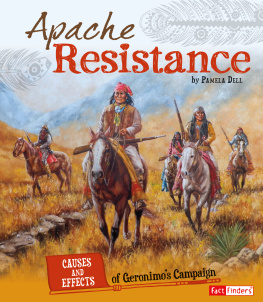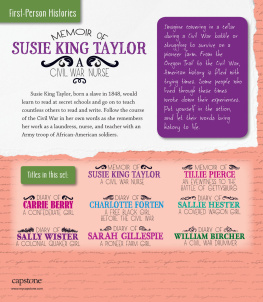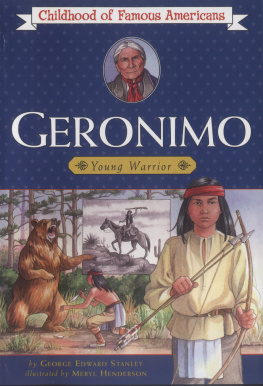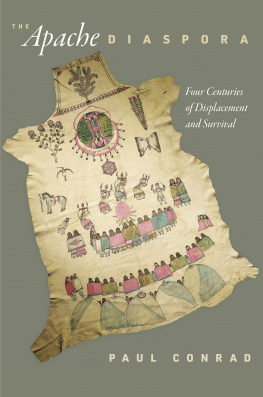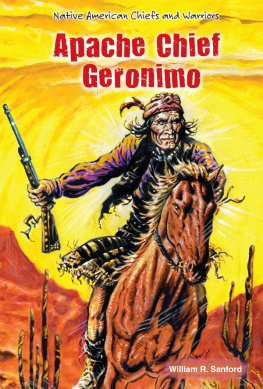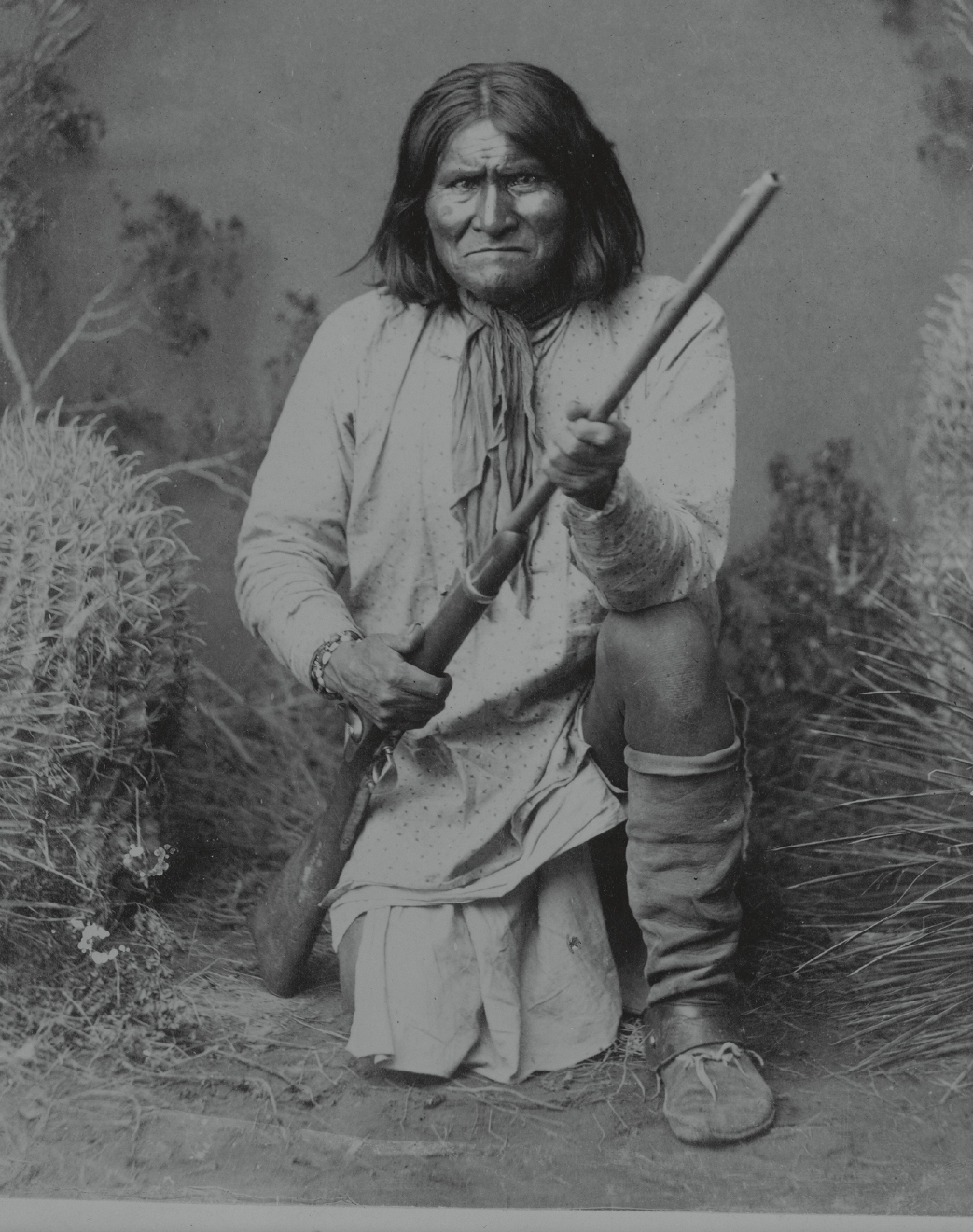TIMELINE
- Early 1820s: Geronimo is born at the headwaters of the Gila River, near the border of Arizona and New Mexico.
- March 4, 1851: Geronimo loses his wife, children, and his mother in a massacre by Mexican forces.
- 1850s1870s: Geronimo leads a relentless campaign against Mexicans and American settlers trying to protect his people and their Apache homelands.
- 1872: The U.S. government establishes the Chiricahua Reservation in southern Arizona and forces Geronimo and other Apache to live there.
- 1876: The U.S. Army relocates Geronimo and his followers to the San Carlos Reservation in Arizona; a defiant Geronimo escapes and begins raiding from the Sierra Madre Mountains in Mexico.
- April 21, 1877: Geronimo is captured in Ojo Caliente and taken to live on the San Carlos Reservation.
- 1878: Geronimo and his followers flee the reservation, returning in 1880. They leave again in 1881.
- 1882: Geronimo and his followers attack the reservation and take hundreds of Apache with them.
- September 3, 1886: After a massive military hunt for the fugitive, Geronimo surrenders for the final time, to General Nelson A. Miles.
- October 25, 1886: After several weeks imprisoned in Texas, Geronimo and several other Apache prisoners of war are sent to Fort Pickens, Florida. Their families are sent to Fort Marion in Florida.
- May 13, 1888: Geronimo and other Apache prisoners are relocated to Mount Vernon Barracks in Alabama, where they are reunited with their families.
- October 4, 1894: Geronimo and 258 other prisoners of war are taken to Fort Sill in Oklahoma Territory.
- 1904: Geronimo appears as a celebrity at the St. Louis Worlds Fair.
- March 9, 1905: A few days after appearing in President Theodore Roosevelts inaugural parade, Geronimo pleads the case for his people to return to their Arizona homelands, but the president denies his request.
- February 17, 1909: Geronimo dies at Fort Sill, Oklahoma, and is buried in the Apache cemetery there.
- February 23, 2009: The U.S. House of Representatives passes Resolution 132 honoring Geronimos life and acknowledging the wrongs done to him and his people.
GLOSSARY
(BAND) group of related people who live and hunt together (BAUN-tee) money offered for killing or capturing someone (kam-PAYN) series of battles fought in one region (KUHS-tuh-dee) imprisonment (fruhn-TIHR) the far edge of a settled area, where few people live (HOSS-tij) person taken by force and held, often as a way to obtain something (EYE-kon-ik) widely viewed as perfectly capturing the meaning or spirit of something or someone (in-AW-ger-ul) swearing in (MASS-uh-kuhr) the deliberate killing of a group of unarmed people (PROF-eh-see) something that a person says will happen in the future (PROSS-pekt-or) person who looks for valuable minerals, especially silver and gold (RASH-uhn) a persons daily share of food (REN-uh-gade) someone who rejects lawful behavior (rez-er-VAY-shuhn) area of land set aside by the U.S. government for American Indians; in Canada reservations are called reserves (ro-MAN-ta-size) treat as idealized (SKOWT) someone who travels ahead of a military group to gather information about the enemy
READ MORE
- Birchfield, D.L., and Helen Dwyer.Apache History and Culture. Native American Library. New York: Gareth Stevens Pub., 2012.
- Collins, Terry.Into the West: Causes and Effects of U.S. Westward Expansion. North Mankato, Minn.: Capstone Press, 2014.
- Spilsbury, Richard.Geronimo. Hero Journals. Chicago: Raintree, 2014.
CRITICAL THINKING USING THE COMMON CORE
- What reasons did the Apache have for continually raiding in the Southwest? Do you think their raids were justified? Why or why not? (Integration of Knowledge and Ideas)
- Once Geronimo surrendered for the last time, why did the government keep him prisoner for the rest of his life? Do you think Geronimo would have lived peacefully if he had been allowed to return to his Arizona homelands? (Key Ideas and Details)
- Examine the map on . Which locations were the last three places Geronimo lived? What were conditions like for him? (Craft and Structure)
THE GREAT WARRIOR GERONIMO
A baby with a great destiny was born in about 1823. He was given the name Goyahkla, meaning one who yawns. But as this young Apache grew up, he came to prove his name false. He became known as Geronimo, one of the fiercest warriors in American history.
The first photo of Geronimo was taken in 1884. Various spellings of his name included Goyahkla and Goyathlay.
Geronimo was born into the Bedonkohe , and government troops began moving west onto Apache lands.
Along with other tribe members, Geronimo fought these enemies. But in the early 1850s a single terrible event set the course of the young warriors life. From that time forward, Geronimo dedicated himself fully to fighting the Mexicans and then the Americans. His long bitter struggle made Geronimos name impossible to forget.
WHAT CAUSED GERONIMOS CAMPAIGN?
In the 1800s Indian territory was being threatened on all sides. Geronimos war was part of a wider American Indian rebellion against people taking their lands. Three main causes triggered Geronimos long-fought across the Southwest.
Cause #1: Centuries of Conflict
For centuries before Geronimos birth, the Apache and the Mexicans had fought viciously for land, resources, and justice. The Apache frequently swooped in to raid towns in the Mexican states of Sonora and Chihuahua. The Mexican government could not stop the attacks.
The Apache lived in the Southwests rugged mountains and deserts. Food and other supplies were hard to come by, so raiding was an accepted part of Apache culture. Geronimo became a warrior by age 17. He almost certainly joined in raiding from that time on. The Apache went after weapons and livestock, especially horses. They murdered and took to anyone who killed or captured an Apache.
The Apache had no choice but to go on raids to survive as more and more of their land was taken over.
FAST FACT
Legend says that the Mexicans shouted Cuidado! (Spanish for Watch out!) Geronimo! whenever their Apache enemy appeared. This may have been their version of the name Goyahkla. But some historians think the Mexicans were calling for protection from St. Jerome, which is Geronimo in Spanish.
Cause #2: Mexican Massacre
To avoid raids, the Chihuahuan government in Mexico began giving the Apache food in early 1851. But on March 5, a band of Mexicans rode near Janos, Chihuahua, to hunt down Apache. That day Geronimo and other Apache men had gone into Janos to trade. Their wives and children remained camped a few miles outside town with a handful of warriors to guard them.

